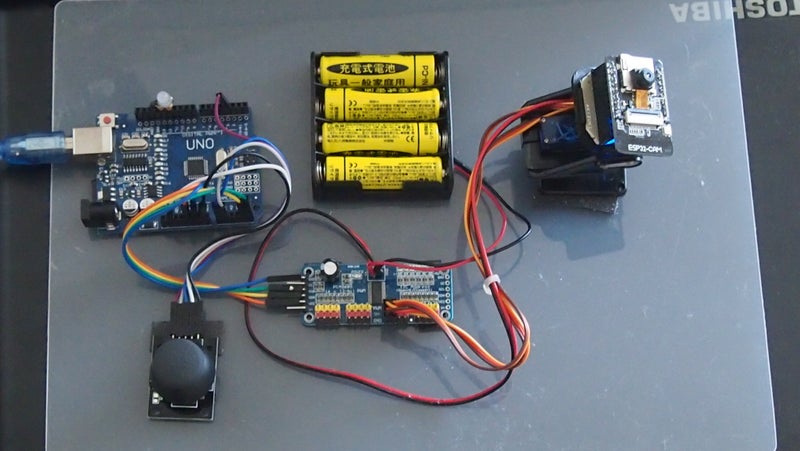【2020年最新の改良版】タブレット スタンド タブレット アーム スタンド 横/縱き 寝ながら ipad iphone アーム ベッド用 360回転の スマホ スタンド/ホルダー 4つの関節を採用 4〜11インチ for iPad Pro 、iPad 、Kindle Fire 、Nintendo Switch、android surface、iPhone X多機種対応 黒【日本語取扱説明書】
Amazon(アマゾン)
1,999円

//LEDECO.com //Shinji Tsuda
//2020.010.15
#include <Wire.h>
#include <LiquidCrystal_I2C.h>
#include "RTClib.h"
#include <DHT.h>
LiquidCrystal_I2C lcd(0x27, 16, 2); // set the LCD address to 0x27 for a 16 chars and 2 line display
RTC_DS1307 RTC;
const int PIN_DHT = 8;
DHT dht(PIN_DHT, DHT11);
void setup()
{
lcd.init(); // initialize the lcd
// Print a message to the LCD.
lcd.backlight();
lcd.setCursor(0, 0);
lcd.print("Hello, world!");
lcd.setCursor(0, 1);
lcd.print("Arduino!");
delay(1000);
lcd.setCursor(0, 0);
lcd.print(" LEDeco.com ");
lcd.setCursor(0, 1);
lcd.print(" Shinji,TSUDA ");
delay(1000);
Serial.begin(9600);
dht.begin();
Wire.begin();
RTC.begin();
if (! RTC.isrunning()) {
Serial.println("RTC is NOT running!");
// following line sets the RTC to the date & time this sketch was compiled
}
RTC.adjust(DateTime(__DATE__, __TIME__));
}
void loop()
{ // set the cursor to column 0, line 1
// (note: line 1 is the second row, since counting begins with 0):
// print the number of seconds since reset:
//lcd.print(millis() / 1000);
delay(100);
float humidity = dht.readHumidity();
float temperature = dht.readTemperature();
Serial.print("Humidity: ");
Serial.print(humidity);
Serial.println("%\t");
Serial.print("Temperature: ");
Serial.print(temperature);
Serial.println(" *C");
DateTime now = RTC.now();
Serial.print(now.year(), DEC);
Serial.print('/');
Serial.print(now.month(), DEC);
Serial.print('/');
Serial.print(now.day(), DEC);
Serial.print(' ');
Serial.print(now.hour(), DEC);
Serial.print(':');
Serial.print(now.minute(), DEC);
Serial.print(':');
Serial.print(now.second(), DEC);
Serial.println();
delay(1500);
lcd.setCursor(0, 0);
lcd.print("Ondo : " + String(temperature) + "*C");
lcd.setCursor(0, 1);
lcd.print("Sitsudo: " + String(humidity) + "%");
delay(1500);
lcd.setCursor(0, 0);
lcd.print("Temp : " + String(temperature) + "*C");
lcd.setCursor(0, 1);
lcd.print("Humid : " + String(humidity) + "%");
delay(1500);
lcd.setCursor(0, 0);
lcd.print(" DAY :");
lcd.print(now.year(), DEC);
lcd.print('/');
lcd.print(now.month(), DEC);
lcd.print('/');
lcd.print(now.day(), DEC);
lcd.print(' '); lcd.print(' ');
lcd.setCursor(0, 1);
lcd.print(" TIME: ");
lcd.print(now.hour(), DEC);
lcd.print(':');
lcd.print(now.minute(), DEC);
lcd.print(':');
lcd.print(now.second(), DEC);
lcd.print(' '); lcd.print(' ');
lcd.print(' '); lcd.print(' ');
delay(1500);
lcd.setCursor(0, 0);
lcd.print("HINITI");
lcd.print(now.year(), DEC);
lcd.print('/');
lcd.print(now.month(), DEC);
lcd.print('/');
lcd.print(now.day(), DEC);
lcd.print(' '); lcd.print(' ');
lcd.setCursor(0, 1);
lcd.print("JIKAN ");
lcd.print(now.hour(), DEC);
lcd.print(':');
lcd.print(now.minute(), DEC);
lcd.print(':');
lcd.print(now.second(), DEC);
lcd.print(' '); lcd.print(' ');
lcd.print(' '); lcd.print(' ');
delay(1500);
}
#define LED_0 0
#define LED_1 1
#define LED_2 2
#define LED_3 3
#define LED_4 4
#define LED_6 6
#define LED_7 7
#define LED_8 8
#define LED_9 9
void setup() {
pinMode(LED_BUILTIN, OUTPUT);
pinMode(LED_0, OUTPUT);
pinMode(LED_1, OUTPUT);
pinMode(LED_2, OUTPUT);
pinMode(LED_3, OUTPUT);
pinMode(LED_4, OUTPUT);
pinMode(LED_6, OUTPUT);
pinMode(LED_7, OUTPUT);
pinMode(LED_8, OUTPUT);
pinMode(LED_9, OUTPUT);
}
void loop() {
// LED Off
digitalWrite(LED_BUILTIN, HIGH);
digitalWrite(LED_0, LOW);
digitalWrite(LED_1, LOW);
digitalWrite(LED_2, LOW);
digitalWrite(LED_3, LOW);
digitalWrite(LED_4, LOW);
digitalWrite(LED_6, LOW);
digitalWrite(LED_7, LOW);
digitalWrite(LED_8, LOW);
digitalWrite(LED_9, LOW);
delay(300);
// LED On
digitalWrite(LED_BUILTIN, LOW);
digitalWrite(LED_0, HIGH);
delay(300);
digitalWrite(LED_1, HIGH);
delay(300);
digitalWrite(LED_2, HIGH);
delay(300);
digitalWrite(LED_3, HIGH);
delay(300);
digitalWrite(LED_4, HIGH);
delay(300);
digitalWrite(LED_6, HIGH);
delay(300);
digitalWrite(LED_7, HIGH);
delay(300);
digitalWrite(LED_8, HIGH);
delay(300);
digitalWrite(LED_9, HIGH);
delay(300);
digitalWrite(LED_0, LOW);
digitalWrite(LED_1, LOW);
digitalWrite(LED_2, LOW);
digitalWrite(LED_3, LOW);
digitalWrite(LED_4, LOW);
digitalWrite(LED_6, LOW);
digitalWrite(LED_7, LOW);
digitalWrite(LED_8, LOW);
digitalWrite(LED_9, LOW);
delay(100);
digitalWrite(LED_9, HIGH);
delay(300);
digitalWrite(LED_8, HIGH);
delay(300);
digitalWrite(LED_7, HIGH);
delay(300);
digitalWrite(LED_6, HIGH);
delay(300);
digitalWrite(LED_4, HIGH);
delay(300);
digitalWrite(LED_3, HIGH);
delay(300);
digitalWrite(LED_2, HIGH);
delay(300);
digitalWrite(LED_1, HIGH);
delay(300);
digitalWrite(LED_0, HIGH);
delay(300);
for (int i = 0; i < 20; i++) {
digitalWrite(0, HIGH);
delay(80);
digitalWrite(1, HIGH);
delay(80);
digitalWrite(2, HIGH);
delay(80);
digitalWrite(3, HIGH);
delay(80);
digitalWrite(0, LOW);
delay(80);
digitalWrite(4, HIGH);
delay(80);
digitalWrite(1, LOW);
delay(80);
digitalWrite(6, HIGH);
delay(80);
digitalWrite(2, LOW);
delay(80);
digitalWrite(7, HIGH);
delay(80);
digitalWrite(3, LOW);
delay(80);
digitalWrite(8, HIGH);
delay(80);
digitalWrite(4, LOW);
delay(80);
digitalWrite(9, HIGH);
delay(80);
digitalWrite(6, LOW);
delay(80);
digitalWrite(7, LOW);
delay(80);
digitalWrite(8, LOW);
delay(80);
digitalWrite(9, LOW);
delay(80);
digitalWrite(9, HIGH);
delay(80);
digitalWrite(8, HIGH);
delay(80);
digitalWrite(7, HIGH);
delay(80);
digitalWrite(6, HIGH);
delay(80);
digitalWrite(9, LOW);
delay(80);
digitalWrite(4, HIGH);
delay(80);
digitalWrite(8, LOW);
delay(80);
digitalWrite(3, HIGH);
delay(80);
digitalWrite(7, LOW);
delay(80);
digitalWrite(2, HIGH);
delay(80);
digitalWrite(6, LOW);
delay(80);
digitalWrite(1, HIGH);
delay(80);
digitalWrite(4, LOW);
delay(80);
digitalWrite(0, HIGH);
delay(80);
digitalWrite(3, LOW);
delay(80);
digitalWrite(2, LOW);
delay(80);
digitalWrite(1, LOW);
delay(80);
digitalWrite(0, LOW);
delay(80);
}
}

自動アルコール消毒材散布機の製作。アルディーpro mini
前に作ったオート、キレイキレイ、ビオレを改良しました。
センサーを超音波センサからシャープ近接センサに変えてアルディーノminiからアルディーノpro mini
に変えて小型化耐水防水化いてます。
アルディーノスケッチ
//LEDECO.com
//2020.10.05
//赤外線距離センサー SHARP GP2Y0A21
const int PIN_ANALOG_INPUT = 3; // アナログピン3番のセンサーの値を読込む
#include <Servo.h>
Servo myservo1;
Servo myservo2;
void setup() {
Serial.begin(9600);
pinMode(5,OUTPUT);
pinMode(6,OUTPUT);
myservo1.attach(8);
myservo2.attach(9);
delay(1000);
myservo1.write(0);
myservo2.write(0);
delay(1000);
}
void loop() {
int i = analogRead( PIN_ANALOG_INPUT );
if ((i) > 450){
digitalWrite(6,HIGH);
digitalWrite(5,HIGH);
delay(100);
myservo1.write(150);
myservo2.write(150);
delay(1000);
myservo1.write(0);
myservo2.write(0);
delay(1000);
}
if ((i) > 350) {
digitalWrite(5,HIGH);
digitalWrite(6,LOW);
delay(100);
}
if ((i) > 250){
digitalWrite(5,LOW);
digitalWrite(6,HIGH);
delay(100);
}
else{
digitalWrite(5,LOW);
digitalWrite(6,LOW);
delay(100);
}
}